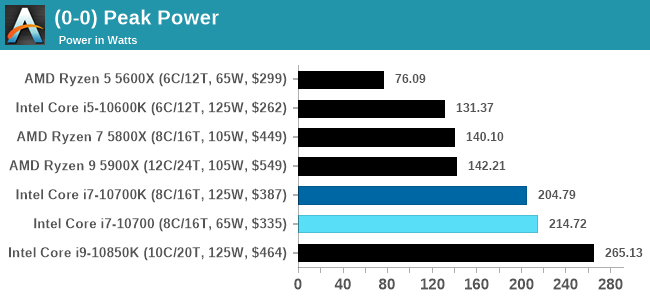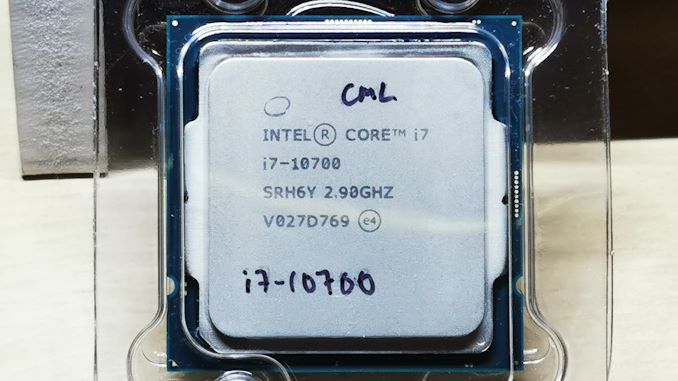Intel Core i7-10700 vs Core i7-10700K Review: Is 65W Comet Lake an Option?
by Dr. Ian Cutress on January 21, 2021 10:30 AM EST- Posted in
- CPUs
- Intel
- Core i7
- Z490
- 10th Gen Core
- Comet Lake
- i7-10700K
- i7-10700
Conclusion: TDP is Not Fit For Purpose
In years gone by, processors were sold with a single frequency and power rating. It was very quickly realized that if a processor could effectively go to sleep, using either lower voltage or lower frequency (or both) then a lot of idle power could be saved. Going the other way, processor designers realized that for temporary short bursts, a core could run at a higher frequency before it reached a thermal limit. Also, using a multi-core processor meant that either the power budget could be shared across all the cores, or it could be focused in one.
Both AMD and Intel have noticed this over time, and both companies have different attitudes on how they report numbers relating to ‘base frequency’ and related power as well as the bursty ‘turbo frequency’ and related power. Out of those four metrics, the only one Intel doesn’t provide is turbo power, because from their perspective it is system dependent.

Intel lets motherboard manufacturers determine how long a system can turbo for, and what that budget is. Intel encourages motherboard manufacturers to over-engineer the motherboards, not only for overclocking, but for non-overclockable CPUs to get the best performance for longer. This really messes up what the ‘default out-of-the-box performance’ should be if different motherboards give different values. The trend lately is that enthusiast motherboards enable an unlimited turbo budget, and the user building their system just has to deal with it.
This means that users who buy the Core i7-10700 in this review, despite the 65 W rating on the box, will have to cater for a system that will not only peak around 215 W, but sustain that 215 W during any extended high-performance load, such as rendering or compute. We really wished Intel put this 215 W value on the box to help end-users determine their cooling, as without sufficient guidance, users could be hitting thermal limits without even knowing why. At this point, 'Intel Recommended Values' for turbo time and budget mean nothing outside of Intel's own OEM partners building commercial systems.
Core i7-10700 vs Core i7-10700K Performance
In the review we highlighted that these two processors have a peak turbo frequency difference of 300 MHz and an all-core turbo frequency difference of 100 MHz. The fact that one is rated at 65 W and the other is rated at 125 W is inconsequential here, given that most end-user motherboards will simply enable turbo all the time. This means the performance in most of our tests between the two is practically identical, and consummate to a 100-300 MHz frequency difference.
In practically all of our tests, the Core i7-10700K is ahead by a super slim margin. At $387 for the 10700K compared to $335 for the 10700, the performance difference is not enough to warrant the $52 price difference between the two. Performance per dollar sides mostly with the Core i7-10700, although users getting the i7-10700K will likely look towards overclocking their processor to get the most out of it – that ultimately is what to pay for.
The other comparison point is with the Ryzen 5 5600X, which has two fewer cores but costs $299. In practically every test, the increased IPC of the Ryzen over Intel means that it sits identical with the Core i7 processors, AMD is cheaper on list price, and at a much lower power (AMD will peak around 76 W, compared to 215 W). AM4 motherboards are also abundant, while corresponding Intel motherboards are still expensive. The problem here however is that AMD is having such high demand for its product lines right now that finding one in stock might be difficult, and it probably won’t be at its recommended price.
Users in this price bracket have a tough choice – the more efficient AMD processor that might be in stock, compared to the Intel processor that will be in stock but more cooling will likely be required.











210 Comments
View All Comments
Marlin1975 - Thursday, January 21, 2021 - link
"65 watt" you keep using that word, I don't think it means what you think it means.YB1064 - Thursday, January 21, 2021 - link
From the first peak power chart, the 10700K consumes almost twice as much power as an equivalent AMD offering at that price point. The "65W" number is blatantly false advertising.heickelrrx - Friday, January 22, 2021 - link
10700k is not 65w part, 10700 is the one that labeled as 65wSamus - Friday, January 22, 2021 - link
Intel is just lying at this point as they are 'effectively' ~215w parts if you put them in a motherboard from Asus, Asrock, MSI, Gigabyte, etc. Only in an OEM system like an HP Elitedesk or Dell Workstation will they run anywhere close to their TDP rating but I'd guess they are using PL2 as well because why not, Intel said its ok.It's become painfully obvious Intel has had to resort to extreme measures here to compete. And compete is a pretty loose definition as they are using almost double the power of the competition and still slower clock for clock, dollar for dollar. No wonder Intel has shaken up the ranks, this is embarrassing.
Smell This - Friday, January 22, 2021 - link
The AMD 3rd Gen Ryzen Deep Dive Review:3700X (65w) and 3900X Raising The Bar
https://www.anandtech.com/show/14605/the-and-ryzen...
I snagged a Ryzen 3700X 8c/16t for $280 3 months ago. The price is at $325 or so these days until it is supplanted by a Ryzen 5700X. Makes the Core i7-10700 at 197w very, very sad.
Fully loaded (by Andrei & Gavin) was around 90w.
bananaforscale - Monday, January 25, 2021 - link
Doesn't matter, 10700 isn't really a 65W part either. I can deal with a 105W Ryzen pulling 150W under full load but having a "65W" part pull 215W is just BS. That's over triple and will overstress crap VRMs.III-V - Friday, January 22, 2021 - link
It's peak power... Not sustained power, which is what TDP deals with.shabby - Saturday, January 23, 2021 - link
It's 2.9ghz base clock uses 65w, that's what the tdp rating basically is.It would be nice if anandtech posted the actual wattage during each test for each cpu. Not just for many fps it got but how much wattage it used in that test.
Qasar - Saturday, January 23, 2021 - link
specially for games. keep reading how some say in games, intel is still better then amd when it comes to power usage, but dont really see much about it.scottlarm - Saturday, January 23, 2021 - link
gfh